- Discussion of the Assemblage in Korea, with special reference to Yésou (2001 & 2002).
- Taimyrensis versus yellow-legged Vega Gull.
- Mongolian Gull: subspecies of Vega or specifically distinct?
- Summary
Page 2
Mongolian Gull
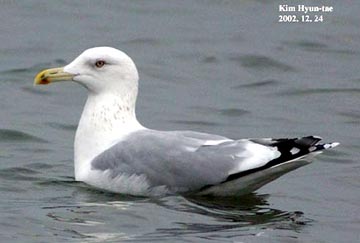
Photo © Kim Hyun-Tae.
Adult winter Type A Mongolian Gull. A fairly typical individual, showing very fine nape streaking and obvious dark bill markings.
Although all taxa of the Assemblage can show clean white heads (retained from breeding plumage) into October, Mongolian Gulls are unique within the Assemblage occurring in Korea in that they remain largely white-headed even in mid-winter: some show only the faintest grayish hind nape streaking, while others at most show coarser hind nape streaking and a very faint dusting up onto the crown. Juvenile and first winter plumages wear and advance more rapidly than similar ages of Vega and Taimyr, and are also white-headed when similar-aged Taimyr and Vega Gulls are invariably much browner-headed.
Based on differences in structure and mantle coloration, and to a lesser extent on habitat preference, possibly three or four forms (or considering their fragmented breeding range, populations?) of Mongolian Gull apparently occur in South Korea in winter. What is believed to be to be Type A (see below) mongolicus Mongolian Gull has also even been found nesting on remote (and restricted access) offshore islands off the Korean west coast, sharing colonies with Black-faced Spoonbill Platelea minor, Chinese Egret Egretta eulophotes and Black-tailed Gull.
As there are both very large and occasional small individuals with clean white heads in mid-winter (which may or may not refer to the subspecies mongolicus as presently described: see the discussion below) it is not easy to make overly broad generalizations on structure, but the most widespread forms are all rather large (often similar to or larger than most Vega), long-billed, with long foreheads, deep-chests and noticeably long-wings (both at rest and in flight): the smallest and scarcest form ("Type C") has a typically long-winged Mongolian Gull type profile in flight but is distinctively more delicate, with a rounded head shape and short bill suggestive of Iceland Gull L. glaucoides.
Mongolian Gull can be seen in very small numbers throughout the summer (with between 40-50 sometimes remaining at Seosan for example: Kim in lit.), with juveniles appearing along the west coast in August, and larger numbers of adults and immatures arriving from mid-September. Apparent migration peaks in mid-October, though large numbers remain to winter at favored sites. Northward migration is evident in March, with most departed by early May.
Plumage
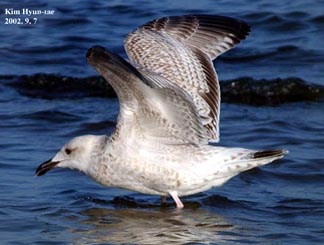
Photo ©Kim Hyun-Tae.
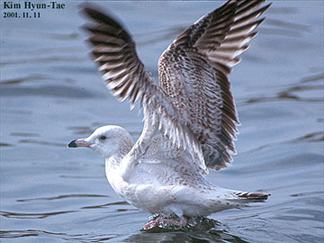
Photo © Kim Hyun-Tae.
The innermost primaries appear comparatively translucent, with contrasting, distinctively pale subterminal marks. The underwing is obviously paler than in other members of the Assemblage, with faintly barred axillaries, and often darker edges to the coverts.
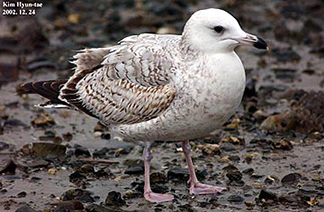
A reasonably lightly-built, pale individual. Note the white-headedness, with unmarked crown, contrasting with heavier hind-nape streaking, and grey wash around the eye; the heavily frayed tertials; the rather narrow black tail band fringed white; the long primary projection and the slightly bulbous bill which is cleanly pink-based and black distally.
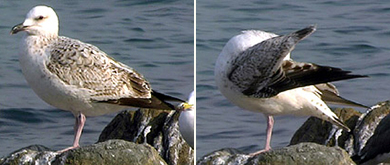
Photo © Charlie Moores
Presumed 1st W Mongolian Gull, February. This presumed 1st W Mongolian Gull shows a largely dark bill even into February, and apparently some darker outer greater coverts (more obvious in the image than in the field).
The range of plumage of juvenile and first winter Mongolian Gull is far from well understood, as some are dark (somewhat suggestive perhaps of cachinnans / heuglini) and some rather paler, differences that could reflect either individual variation or their population of origin. Most however, based on a combination of jizz and plumage, are rather distinctive.
According to Koerkamp’s observations at Lake Baikal (on Martin Reid’s website) most juveniles in mid-August show rather dark underparts (relative to juvenile cachinnans or michahellis) and a highly variable tertial pattern. The wings show a clear window on the inner primaries, with rather light greater coverts (with no greater covert bar), and the tail is white with a clear-cut black band and white tips to the tail feathers. In addition, the underwing is not white as in typical cachinnans instead being more reminiscent of michahellis. The bills are largely black.
At the same time birds starting to appear in Korea at a number of west coast sites often already appear distinctively pale-headed with contrasting dense markings on the lower hindnape. Paler birds show very pale underparts only faintly marked brownish, with faint(er) barring on the vent and undertail coverts. The upperparts are heavily scaled black, grey, and white, and the conspicuous tertials are blackish with an un-notched (or very faintly notched) broad white fringe. The coverts are neat, and clean-fringed, lacking a darker outer greater covert bar. Darker types show rather more obvious dirty mottling on the upperparts, and are rather browner and less clean-looking, though still with distinctively scaley upperparts. Some perhaps show more solidly dark outer greater coverts, though it remains unclear whether this represents expected variation within Mongolian Gull (Ujihara in lit.) or whether many such individuals might instead refer to hybrids or even misidentified taimyrensis or heuglini.
In flight, all juveniles show pale and rather plain underwings, though the coverts are typically edged browner. They have a broad white rump, extensive pale on the uppertail coverts and the bases of the (weakly barred or spotted) tail feathers, and a comparatively narrow black tail band, tipped white.They also show a strikingly dark secondary bar, a relatively indistinct or occasionally Vega-like blaze at the base of the primaries (with the innermost 4-5 primaries also showing some dark subterminal markings). Juveniles have largely dark bills, though even in August-September they can show some pink basally.
By mid-September/early October many appear white-headed (several months before some Vega even appear pale-headed), set off by increasingly well-defined dark streaks on the hindnape (apparently lacking in Vega), and some even show pale grey coming through on the mantle. Distinctively, by December the tertials of many first winter Mongolian Gulls can also start to appear worn and frayed.
Note difference in bill base colour between the massive individual in images 24 and 25, and the bird in images 26 and 27.
By January and February, the palest birds show only faint scaling above (having bleached largely whitish above and below) with dark frayed tertials and contrasting, isolated dark centers to e.g. the scapulars. In flight, they often show rather obvious "headlights" (whitish patches on the marginal coverts) and a translucent wedge to the underside of the outermost secondaries and innermost primaries.
Bill colour of first winters is variable: by January the bills of the palest birds are extensively pink basally with a clean-cut black tip, whilst those of darker birds appear a somewhat dirtier pink and still have a dark cutting-edge.
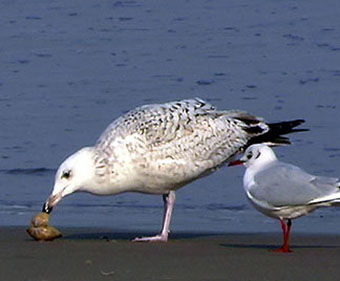

Identification of many adults in September and even October, when occasional "white-headed" vegae are considered to still occur, needs to be based largely on primary moult with mongolicus typically showing the most and taimyrensis the least advanced moult (Ujihara in lit.). However, the variability of moult within the taxa of the Assemblage remains imperfectly known, and as individuals showing clean white heads are also likely to show slower primary moult, identification of many autumn white-headed birds should for the present remain tentative.
Most Mongolian Gull during and after the post-breeding moult also show fine streaking on the hind-nape, and a grayer wash around the eye: features that are largely retained throughout the winter until February, when some start to move back into breeding plumage. Most such Mongolian Gulls in the mid-winter period look small-eyed, with variable eye-colour and a vermilion-red eye-ring (similar to that shown by Vega and Taimyr Gulls). They are also longish-legged and longish-winged, with a rather longer primary projection beyond the tail than shown by Vega Gull. There is an obvious range in structure, however, and also in the tone and the darkness of the grey parts (as suggested by Yesou, 2001), in most birds concomitant with the extent of streaking on the nape and the overall structure, in others less obviously so. At least occasional birds even appear to be as dark as typical taimyrensis.
The perceived variability in Mongolian Gull is best described under four main groupings, with the proviso that of course much still remains to be found/confirmed through further studies.

Photo © Kim Hyun-Tae
Based on typical moult, the left bird in is considered most likely to be taimyrensis, and the bird right it to be vegae (Ujihara in lit.). However, both were also considered Mongolian Gull on the basis of bill size; eye colour; and complete absence of head streaking (Yesou in lit.to Kim H-T.).
Features considered by the author to be typical of Mongolian Gull include the full-naped head (with small eye), heavy-set body, long attenuated look (with extensive primary projection), and grey-pink leg color of the paler bird. Although Mongolian Gull show pink-toned legs in Korea in winter, many show yellow tones in breeding plumage, as in the darker-mantled individual.
Although Yesou concluded that the darker mantle of the left bird was probably an effect of light, the right bird shows that in direct comparison it was as dark or darker than Black-tailed Gull.
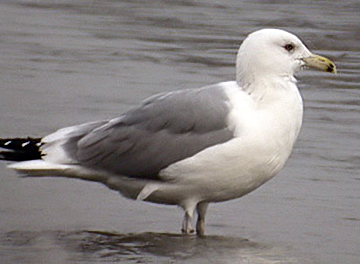
Photo © Nial Moores
Second dark-mantled Mongolian Gull, January. Larger and with a darker grey mantle than vegae, similar to Black-tailed Gull, in direct comparison at many angles. Presence of near complete bill band much more usual in Mongolian than other members of the Assemblage.
Type A
In terms of overall structure and mantle coloration Type A is considered by the author to be closest to the mongolicus nesting in Lake Baikal (described in Yesou 2001). It is the most numerous type in Korea (contra Birds of South Korea), and the commonest member of the Assemblage found in freshwater habitats (e.g. on the River Han in Seoul and on freshwater reservoirs at Seosan). On the Han River in Seoul counts have revealed several thousand individuals at peak, especially during migration (J-Y Park, pers com.), with many remaining throughout the winter. They significantly outnumber other gulls, e.g. 385 were present along one 2 km stretch of river on January 17, 2003, compared with only 18 Vega.
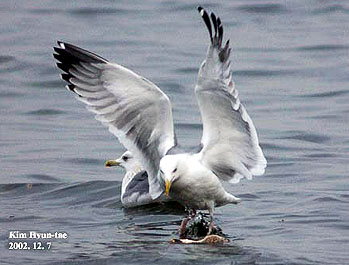
Winter adult Mongolian Gull feeding on Spot-billed Duck Anas poecilorhyncha (with winter adult vegae behind). Spread wing from below shows only one small mirror on p 10 and black tips to only 6 primaries (with a small dark mark on p4): presumably not typical of mongolicus nesting in lake Baikal, that also usually show a small mirror on p9, and 7 black-tipped primaries (Yesou, 2001).
Based on video stills and the impressions of observers, this is also the type found nesting on Seok Island off South Korea. Based on different video footage the same, or a similar type, also nests on some islands off the coast of North Korea. Although direct comparison with vegae was not possible, comparison with sympatric Black-tailed Gulls suggested that the mantle colour might, however, be slightly darker than the more typical mongolicus found in Korea in winter.
They are rather large, deep-chested and full-bodied, with a fairly narrow attenuated rear end. They typically show long, parallel-sided bills, narrower at the base, that lack a strong gonydeal angle, and are sometimes slightly thicker and more blunt at the tip. Close-up images taken in summer (Yesou, 2001; Kim S-M, unpublished) reveal extensive feathering along the underside of the bill, with feathering also extending in a narrow point along the upper and lower mandibles. Most individuals have a distinctive head shape: longish forehead, low crown, and a fairly, full, swollen rear to the head.
In flight, they look long-winged with a somewhat narrow wing-base, the fuller hand held angled more strongly backward, and the neck and head appearing rather long and prominent, combining to create an obviously different profile to Vega in direct comparison.
Despite the alert posture in some of the photographs , Type A seems structurally (and in grey upperpart tones) to concur reasonably well with birds photographed at Lake Baikal (e.g. at rest in plates 87 and 88, and in flight, plates 93 and 94: Yesou, 2001).
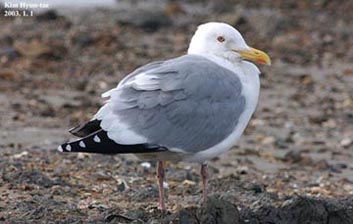
Adult Mongolian Gull. Another typical individual, though with deeper bill colour and complete lack of head streaking suggesting breeding plumage.
Such individuals appear to complete their primary molt more rapidly than Vega and (especially) Taimyr Gulls, and are invariably almost completely white-headed throughout the winter, with only very faint markings on the hind-nape. The mantle is cleaner bluer-grey and rather paler than that of Vega in direct comparison, and the leg colour is invariably grayish pink or pink in mid-winter. Out of more than 150 birds closely checked in mid-January 2003, none showed yellow or yellowish tones - though a small but increasing number of yellowish legged individuals begin to appear in early spring, perhaps peaking in April (see below). The bill colour of adult Type A birds appears to be variable, with some pale, others more strongly yellow, often with an obviously paler tip. The reddish gonys spot does not seem to extend to the upper mandible, and there is a wide variation in dark markings on the bill. Occasional birds (perhaps 1 in 100 or less) show a near complete black bill band. Adults of Type A are often seen in association with paler type first winters.
On several occasions, some vocalisations (although not at all well documented) sounded more coughing and gruffer than presumed equivalent calls given by Vega in direct comparison.
Type A is an active and often aggressive scavenger: at Seosan and other sites they frequently chase and kill injured or sick waterbirds (especially Anas sp), while on the Han River they often harass and rob feeding Goosander Mergus mergus.
Type B
Especially in spring (April and even May), a small number of rather more ’confident’ looking individuals occur: these appear to have a more strongly blue-grey tone to the mantle, and a more obvious tertial step. Most such individuals show obvious yellowish tones to the legs: some show bright yellow legs. Such observations might involve local breeding birds, more southerly-wintering populations moving north through Korea, or even be due to confusion with other taxa (e.g. more southerly-nesting large yellow-legged birulai see discussion section below).
Type C

Photo © Kim Hyun-Tae
Two possible Type C Mongolian Gulls (extreme left of group, with left to right an apparent pink-legged taimyrensis, a sleeping vegae, and an adult Type A Mongolian Gull). Remarkably small, both birds seem rather dark-mantled, with completely white dome-shaped heads and a "full nape". The bird in the foreground at least shows rather long primary projection and pink legs. In addition, the strong gonys spot does not bleed up onto the upper mandible in either bird, though the front bird has prominent black markings on the upper mandible. Most vegae and taimyrensis show at least some obvious markings on the nape or neck sides into early March.
The scarcest of the types, Type C has been observed by the author on only 2 occasions in southwest Japan (one group containing several individuals), and less than 5 times in South Korea. All observations have taken place in cold winters, between December and the end of February.
It shows a completely white head in winter, with only faint hind-nape streaks, and is pink-legged. It might simply represent a structural extreme of mongolicus, being small and neat-looking (similar to Taimyr Gull), with an obviously rounded head and short bill, with a medium to long primary projection beyond the tail. However, its upperparts are mid-grey or darkish-grey, similar to Vega.
One seen in flight in January 2003 showed extensive dark on the wingtips, with black extending up onto the outer greater primary coverts.
Type D: "The Yellow Sea Gull"

Photo © Charlie Moores
Type D appears to be in many ways intermediate between Type A Mongolian and Vega Gull,though it also shows several very distinctive features that suggest it is perhaps not part of mongolicus.
Similar in size to vegae (or slightly larger) it appears full-chested but rather weak-bellied, with an obvious downward back slope. The head seems to show a fairly obvious ridge above the eye, and looks very narrow when facing head-on. When feeding, it often appears strikingly long-necked and small-headed, with a deep "plump-looking" chest and legs set well apart. The distinctive Common Gull-like outline is offset by the bill-shape: long and slightly drooping with a strong gonydeal angle, and an obvious gape-line.
Adults (and presumed second winters onward) are much darker-mantled than other Mongolian, exceeding in darkness the upperparts’ grey of the darkest Vega and appearing closer to Black-tailed Gull in overcast conditions. Although largely white-headed in early winter, they tend to show strong, concentrated, and well-defined streaking on the hind-nape, somewhat suggestive of first winter Relict Gull L. relictus, and by late winter several also appear to show faint grayer dusting on the crown. In addition, Type D shows a grayer wash around the eye that accentuates rather obvious white eye-crescents. Eye-ring colour has not yet been noted (perhaps as birds are seldom seen close to), and eyes appear dark.
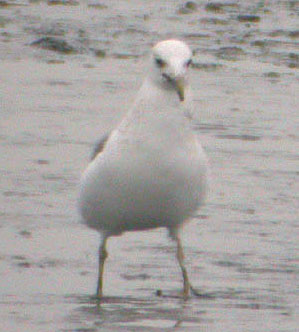
Photo © Nial Moores
Leg colour is either deep pink or pink with some yellowish tones.
In flight, at least two seen well in January 2003 showed only one very small mirror on the outermost primary, and rather extensive black across the wing-tip, combined with a long-winged look suggesting Mongolian Gull Type A.
Though nowhere numerous, it can be expected in very small numbers on any extensive muddy or mud-sand tidal-flats in the northwest (e.g. in Incheon and Asan Bay), where it typically feeds by walking methodically with a rather high-stepping action over mid-level tidal-flats, apparently feeding mostly on shellfish (e.g. small razor clams). Its origin and affinities are rather unclear, but as individuals of this type are often seen together, when they invariably appear rather uniform in appearance, a hybrid origin seems unlikely.
Although Type D shows a mantle coloration similar to taimyrensis (ruling out birulai), with either yellowish or pink legs (ruling out eastern vegae) its identification as a type of Mongolian Gull rather than as Taimyr Gull is based largely on its white-headedness in winter, along with its dark eyes, long-bill and apparent similarity to Mongolian Gull in flight.
Their perceived distinctiveness, their apparent preference for intertidal-flats (a very representative wetland type of the Yellow Sea) and the apparent lack of reference to them in literature or discussion on Mongolian Gull led to the author’s coining of the name "Yellow Sea Gull" for use in discussion with visiting gull enthusiasts. This name, however, is not meant to suggest that this type is either confined to or even nests in the Yellow Sea.
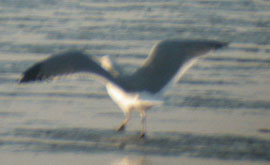
Photo © Nial Moores
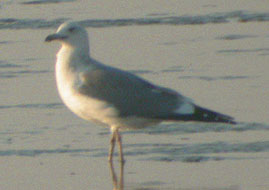
Photo © Nial Moores



